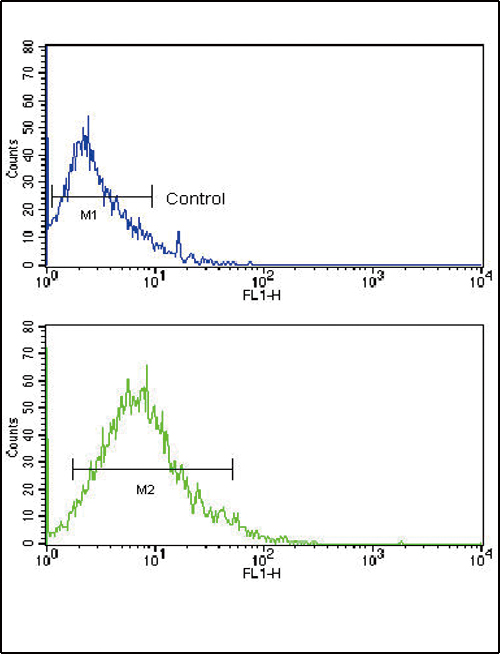GLUT2 (SLC2A2) Antibody (N-term)
Purified Rabbit Polyclonal Antibody (Pab)
- SPECIFICATION
- CITATIONS: 1
- PROTOCOLS
- BACKGROUND

Application
| FC, WB, E |
|---|---|
| Primary Accession | P11168 |
| Reactivity | Human |
| Host | Rabbit |
| Clonality | Polyclonal |
| Isotype | Rabbit IgG |
| Calculated MW | 57490 Da |
| Antigen Region | 31-60 aa |
| Gene ID | 6514 |
|---|---|
| Other Names | Solute carrier family 2, facilitated glucose transporter member 2, Glucose transporter type 2, liver, GLUT-2, SLC2A2, GLUT2 |
| Target/Specificity | This GLUT2 (SLC2A2) antibody is generated from rabbits immunized with a KLH conjugated synthetic peptide between 31-60 amino acids from the N-terminal region of human GLUT2 (SLC2A2). |
| Dilution | FC~~1:10~50 WB~~1:1000 E~~Use at an assay dependent concentration. |
| Format | Purified polyclonal antibody supplied in PBS with 0.09% (W/V) sodium azide. This antibody is prepared by Saturated Ammonium Sulfate (SAS) precipitation followed by dialysis against PBS. |
| Storage | Maintain refrigerated at 2-8°C for up to 2 weeks. For long term storage store at -20°C in small aliquots to prevent freeze-thaw cycles. |
| Precautions | GLUT2 (SLC2A2) Antibody (N-term) is for research use only and not for use in diagnostic or therapeutic procedures. |
| Name | SLC2A2 (HGNC:11006) |
|---|---|
| Function | Facilitative hexose transporter that mediates the transport of glucose, fructose and galactose (PubMed:16186102, PubMed:23396969, PubMed:28083649, PubMed:8027028, PubMed:8457197). Likely mediates the bidirectional transfer of glucose across the plasma membrane of hepatocytes and is responsible for uptake of glucose by the beta cells; may comprise part of the glucose-sensing mechanism of the beta cell (PubMed:8027028). May also participate with the Na(+)/glucose cotransporter in the transcellular transport of glucose in the small intestine and kidney (PubMed:3399500). Also able to mediate the transport of dehydroascorbate (PubMed:23396969). |
| Cellular Location | Cell membrane; Multi-pass membrane protein |
| Tissue Location | Liver, insulin-producing beta cell, small intestine and kidney. |

Provided below are standard protocols that you may find useful for product applications.
Background
Glucose transporter 2 isoform is an integral plasma membrane glycoprotein of the liver, islet beta cells, intestine, and kidney epithelium. It mediates facilitated bidirectional glucose transport. Because of its low affinity for glucose, it has been suggested as a glucose sensor.
References
Freitas,H.S., Nephron Physiol 105 (3), P42-P51 (2007) Laukkanen,O., Diabetes 54 (7), 2256-2260 (2005) Roncero,I., J. Neurochem. 88 (5), 1203-1210 (2004)
If you have used an Abcepta product and would like to share how it has performed, please click on the "Submit Review" button and provide the requested information. Our staff will examine and post your review and contact you if needed.
If you have any additional inquiries please email technical services at tech@abcepta.com.














 Foundational characteristics of cancer include proliferation, angiogenesis, migration, evasion of apoptosis, and cellular immortality. Find key markers for these cellular processes and antibodies to detect them.
Foundational characteristics of cancer include proliferation, angiogenesis, migration, evasion of apoptosis, and cellular immortality. Find key markers for these cellular processes and antibodies to detect them. The SUMOplot™ Analysis Program predicts and scores sumoylation sites in your protein. SUMOylation is a post-translational modification involved in various cellular processes, such as nuclear-cytosolic transport, transcriptional regulation, apoptosis, protein stability, response to stress, and progression through the cell cycle.
The SUMOplot™ Analysis Program predicts and scores sumoylation sites in your protein. SUMOylation is a post-translational modification involved in various cellular processes, such as nuclear-cytosolic transport, transcriptional regulation, apoptosis, protein stability, response to stress, and progression through the cell cycle. The Autophagy Receptor Motif Plotter predicts and scores autophagy receptor binding sites in your protein. Identifying proteins connected to this pathway is critical to understanding the role of autophagy in physiological as well as pathological processes such as development, differentiation, neurodegenerative diseases, stress, infection, and cancer.
The Autophagy Receptor Motif Plotter predicts and scores autophagy receptor binding sites in your protein. Identifying proteins connected to this pathway is critical to understanding the role of autophagy in physiological as well as pathological processes such as development, differentiation, neurodegenerative diseases, stress, infection, and cancer.



